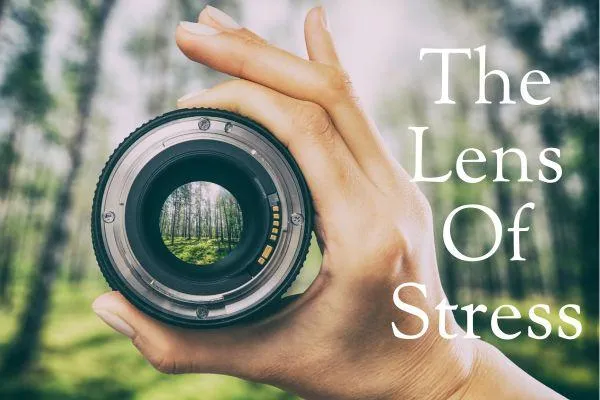Blog
(I no longer post on this blog. Please visit my Substack site for future posts, thank you)

Stress: Are You Living Through the Lens of Stress Without Realising It?
What if I told you that there’s a hidden layer of you secretly shaping your identity, decisions and even your environment? Something so ingrained that you don’t even realise it’s there… until you step away from it.
I didn’t see it either - not at first.
Ambitious, driven, and always pushing for the next goal. Stress? That was just part of the package. Something to manage, something to handle - but never something that controlled me.
However, when I look back, I see it differently. Stress wasn’t just something I dealt with - it was shaping me. The way I saw myself, the choices I made, the way I showed up in my relationships.
I moved to the jungle - yes, literally - and only then did I realise I had been making decisions through the lens of stress, not clarity. And today, I want to share three powerful lessons I learned when I finally broke free from that cycle.
If you feel stuck, overwhelmed, or unsure of what’s next, you might not see the full picture.
Trust me - I know exactly what that feels like.
Lesson 1: Stress Distorts Your Identity
For years, I believed I thrived in high-pressure environments, but I was wrong.
Stress doesn’t just affect your body - it affects who you believe you are.
When you’re constantly in fight-or-flight mode, you adapt to that reality. You think you’re ‘good under pressure,’ when really, you’ve just learned to function in survival mode.
How Running Marathons Became Another Stress Cycle
Nearly 20 years ago, I started running marathons. At first, it was about fulfilling an ambition, but over time, I became obsessed with getting a sub-3:45 finish. I convinced myself that achieving that goal would bring happiness, that it would somehow complete me.
In 2006, I finally did it - 3:43 in Berlin. Running through the Brandenburg Gate, I felt on top of the world. But when I got home, the high vanished, and I found myself thinking…

Me at Berlin airport, still on my PB high! (September 2006)
‘So what?’
The truth hit me hard: The goal had changed nothing.
For four years, I had been running - literally and figuratively - pushing myself, working shifts, never relaxing. Running had become another high-stress cycle. It wasn’t about joy; it was about proving something to myself.
The running itself wasn't the problem, just the mindset behind it. I didn’t run for joy; I ran to fuel the same stress cycle that trapped me at work. I was literally racing through life, both in and out of the office.
An true epiphany came for me when I ran the NYC marathon in 2007, my last race.
Halfway across the Staten Island Bridge at the start, a thought hit me: "What the hell am I doing? Why am I doing this? This isn't fun." I had become so consumed by racing that I no longer knew who I was without the chase.
It took me years to understand what was actually fuelling this in me, but a Chinese proverb quoted in a yoga class finally made it click:
"Tension is who you think you are, relaxation is who you really are."
What yoga can teach us about identity
Yoga offers several lessons that can help when you become consumed by a high-octane identity:
Avidya (misidentification, misconception or delusion): Stress can trick us into thinking titles & achievements = identity.
Abhyasa & Vairagya (effort or practice, and letting go or non-attachment): True clarity doesn’t come from striving - it’s about showing up, doing the work, but not letting stress, perfectionism or external validation define you.
Sthira Sukham Asanam: Yoga (and life) should have both strength (sthira) and ease (sukha).
Too much Sthira (strength) = Burnout, tension, overworking.
Too much Sukha (ease) = Lack of motivation, feeling stuck.
Balance = Progress with sustainability.
Lesson 2: Stress Clouds Your Judgment
When stress takes over, you don’t make clear decisions - you make quick ones.
I used to make decisions out of urgency, feeling like everything needed to be solved right now. But when I look back, I see that many of those choices didn’t align with what I truly wanted—they were simply my nervous system reacting to stress.
Under stress, the rational brain (prefrontal cortex) shuts down, and the emotional brain (amygdala) takes over. This shift leads to reactive, short-term decisions. That’s why, when overwhelm takes hold, we often make impulsive choices for immediate relief instead of ones that genuinely serve us in the long run.
Moving to Costa Rica as a Stress Response
Looking back, I can see that my decision to move to Costa Rica wasn’t just about adventure or a fresh start - it was a decision shaped by stress.

Me at Parque Nacional Marino Ballena (August 2022)
In 2010, I came across a blog by a woman who had moved from Montana to the Caribbean side of Costa Rica. Her story didn’t just inspire me - it felt like an escape route from the life that had me trapped. A life of rigid shifts, constant pressure, and the relentless exhaustion of working in the police force.
I didn’t realise it at the time, but my subconscious was crying out for peace. It made me constantly search for yoga retreats, scroll through travel blogs, and imagine myself somewhere far away from the weight of responsibility. I went to retreats in India, Italy, Bali and yes Costa Rica, yoga festivals in the USA and Canada.
It gave me a glimpse of the calm I desperately needed.
Even now, when I light some Nag Champa, the scent instantly transports me back to my first yoga retreat at Purple Valley in India - a time when I was deeply stressed. That fragrance carries a sense of peace, grounding me in a way that feels almost instinctual. Scent has a powerful link to memory, often triggering feelings of happiness and relaxation, reminding us of the moments when we finally allowed ourselves to breathe (I talk about this in this video).
The more I felt controlled by my circumstances, the more the idea of moving abroad grew into something inevitable. By the time I retired in 2022, the decision had already been made - not by the calm, rational part of me, but by a nervous system that had been crying out for relief for over a decade.
My story wasn't unique
Only when I truly decompressed - when the stress had time to settle - did I recognise the pattern, not just in myself but in so many others who had made similar moves. I started having conversations with people who had also left everything behind. The details were different, but the themes were eerily familiar: bereavement, loss, trauma… A nervous system so overloaded that radical change felt like the only way out.
Lesson 3: You Can’t Heal in the Same Environment That Made You Sick
This was the hardest truth to accept. For years, I believed that if I just ‘managed’ my stress better - tried harder, pushed through, found better coping strategies - I could make it work.
But I learned this the hard way: healing isn’t possible when you’re still surrounded by the same stress triggers, patterns, and pressures that burned you out in the first place.
How I Realised I Was Still in Survival Mode
When I first moved to Costa Rica, I thought the calm would hit me instantly. That the moment I stepped off the plane, all the years of stress would just… disappear. But instead? I actually felt worse. My body was still running on stress mode, even though my external world had slowed down.
At first, it didn’t make sense.I had left my high-pressure job, surrounded myself with nature, and finally made the big, bold change I had dreamed about for years.And yet, I was still waiting for the next crisis. The same patterns of stress that had ruled my life before had simply transferred to a new setting.
New stresses took the place of the old ones - figuring out where to live, buying a car, building new connections. And in some ways, it felt even more intense because these weren’t just work deadlines or difficult bosses; this was about survival.

Me at the beach (February 2024)
Seeking safety
If you’re familiar with the chakra system, this was pure root chakra territory (muladhara) - just like Maslow’s hierarchy of needs - shelter, food, basic security. My nervous system remained on high alert, bracing for impact, scanning for danger and convinced I needed to be ‘on’ at all times. I started to see my old stress patterns in how I moved through my day. I’d walk along the beach fully covered head to toe, fearful of the sun, because after years of working under stress, my body didn’t know how to relax, even in a peaceful environment. I was carrying tension I hadn’t even realised was there.
But the more time I spent in an environment that allowed relaxation, the more those patterns began to break down. It took time - 18 months, to be exact - before I finally began to let go, loosen up and feel a sense of safety I hadn’t experienced in years.
And the moment when I realised it had happened was when I suddenly became aware that I’d stopped googling yoga retreats. And when that moment came, the realisation hit me hard, it wasn’t just my job that had burned me out; it was the way I had been living. The constant stress cycle. Chronic stress. The inability to set boundaries. The resistance to truly resting.
I no longer felt like I needed to escape, I was now actually living my life.
How You Can Start Shifting Out of Survival Mode
Key Takeaways:
Changing environments doesn’t have to mean moving abroad - but it does mean re-evaluating what you expose yourself to daily.
Healing isn’t about escaping stress - it’s about learning to live differently, no matter where you are.
Your nervous system doesn’t just need coping strategies - it needs safety.
If you don’t create space to rest, your body will stay trapped in the same patterns, even if your external world changes.
When I finally allowed myself to slow down, breathe and stop running, I uncovered who I truly was beneath it all. That discovery became the real transformation.
To go deeper, check out my Stress Rescue Kit by clicking the image below. It's your practical no-fluff kit designed to help you reduce stress and recharge in just one week. With 7 guided audio practices and a 38-page plan filled with actionable strategies, you'll discover how to create calm and balance without feeling overwhelmed. Transform your stress into clarity and control - starting with just 20 minutes a day.

© Helen Bee Coaching & Strategy 2025 - All Rights Reserved - Terms & Conditions - Privacy Policy
